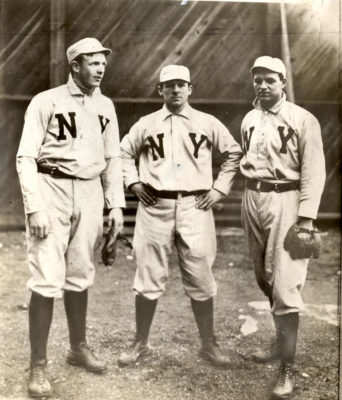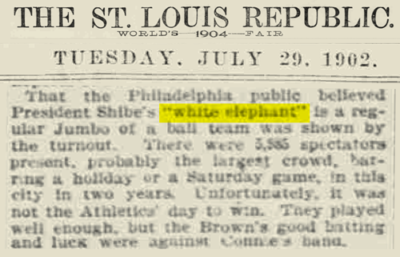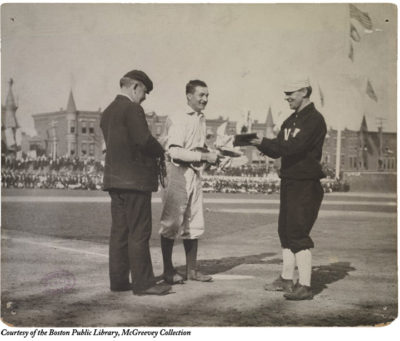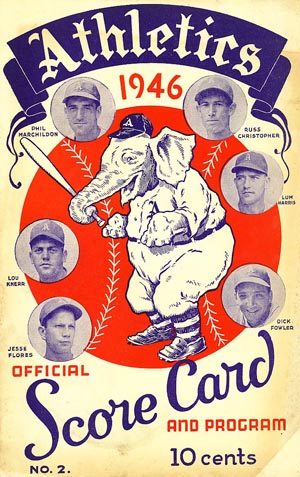Featured Panoramic Photo Above:
Classic Charles Conlon photo of Ty Cobb sliding into Jimmy Austin
Baseball History Comes Alive Now Ranked As a Top Five Website by Feedspot Among All Baseball History Websites and Blogs!
(Check out Feedspot's list of the Top 35 Baseball History websites and blogs)

Guest Submissions from Our Readers Always Welcome! Click for details
Please note: As we compose new blog entries, we will now send each one out to all our subscribers as we post them. Here’s a link to see the entire Blog Archives -GL
THE BASEBALL HISTORY COMES ALIVE BLOG
New Blog Topic: The Philadelphia Athletics “White Elephant”
Have you ever wondered why the Philadelphia Athletics had a “white elephant” as their mascot? Over the years I remember hearing about how they acquired their iconic logo and I knew it had something to do with John McGraw making an off-handed insult. But I had forgotten the details. So I decided to look into it a bit and see what I could find.
Sure enough, I was right about McGraw being directly involved. The story originated back in 1902, the second year of the American League’s existence. At the time, McGraw was the player-manager of the American League Baltimore

Orioles. (I know, it’s hard to think of McGraw being in the American League. After all, he’s associated with the National League’s Baltimore Orioles which won pennants in 1894, ’95, and ’96, and then, of course, with the New York Giants for many years.)
Cankerous sort that he was—and a known umpire baiter—he soon got “into it” with American League president Ban Johnson over his treatment of umpires. Johnson was trying his best to establish a more dignified league; and needless to say, the words “dignified” and ”McGraw” should never be used in the same sentence…at least not back then! McGraw was definitely a problem for Johnson. Plus, I think we can safely assume that there was a huge clash of egos involved.
An ongoing battle of words ensued, one thing led to another, and Johnson suspended McGraw for the remainder of the 1902 season in July. Of course, McGraw wasn’t the type to take something like this lying down. He had plenty of other options and he soon accepted an offer to jump to the National League’s New York Giants for the following season. He let loose with this parting shot on this way out the door:
“The American League is a loser and has been from the start.”
This was just one of the barbs he directed at the upstart league and its owners. He had a particularly good one leveled at Philadelphia A’s owner Ben Shibe:
“He’s so burdened with debt that he has a real ‘white elephant’ on his hands. The team is doomed to fail.”
Of course, the Philadelphia papers picked up on the derogatory quote and tried to hang it around McGraw’s neck. It soon became a rallying point for the young franchise. It was already being described as “famous” less than three weeks after he made the remark. Mugsy proved to be a better manager than a prophet. Here’s what followed (from a recent article in Baseball Digest):
franchise. It was already being described as “famous” less than three weeks after he made the remark. Mugsy proved to be a better manager than a prophet. Here’s what followed (from a recent article in Baseball Digest):
“The Athletics won the 1902 AL pennant and led all major-league clubs in attendance, and by season’s end players and fans had taken to the ‘white elephant’ as the team’s mascot. When the city held a pennant-winning parade along Broad Street, according to newspaper reports, the elephant was a staple of banners and floats.”
Of course, McGraw was not one to let go of a grudge. Just to get back at Johnson, he refused to play the Boston Americans in the 1904 World Series after both teams had won pennants. He had mellowed somewhat by the next year and consented to meet the A’s in the 1905 Fall Classic. By then the Philly fans had embraced the elephant symbol; and at the start of the series, Captain Lave Cross presented McGraw with a miniature elephant statue on a green pedestal. (see photo at right).  The “ever gracious” McGraw readily accepted the gift and bowed in mock courtesy as the crowd roared. The elephant symbol even made an appearance on the cover of the 1905 World Series program.
The “ever gracious” McGraw readily accepted the gift and bowed in mock courtesy as the crowd roared. The elephant symbol even made an appearance on the cover of the 1905 World Series program.
The white elephant was formally adopted as the team’s identity in 1909, appearing on sweaters that year. The mascot has remained part of the team’s identity over the decades, appearing on uniforms, club letterheads, and even promotional materials. After the team moved to Kansas City under the ownership of Charlie Finley, he had the bright idea to banish the elephant mascot and replace it with a mule, which he named “Charlie O.” Then in 1988, new owner Walter Haas restored the iconic symbol to its proper place and it remains part of the franchise’s identity today.
Moral of the story: Always be careful when trashing someone…what you say may come back to bite you!
Gary Livacari
As always, we enjoy hearing your comments
Here’s a link to see the entire Blog Archives



It’s the “Schaefer Boomerang Theory of Life,” Gary. Do or say a bad thing and it’s like tossing a bionic boomerang–it sails way out of sight, then slowly turns in the air, and comes back smack between your eyes!
Intriguing research on Mugsy and the white elephant, one of the many reasons to frequent this website.
Thanks! TOB
Thanks TOB, greart observation!
DD
Apparently Bill Terry didn’t learn this lesson when he took a shot at the Dodgers in 1934. “I was just wondering if (Brooklyn) is still in this league.”
Sure enough the “Schaefer boomerang” came around as the Dodgers knocked the Giants out of the pennant with a critical end of season win at the Polo Grounds.
Good point, Ed…thanks for reminding me of that one!